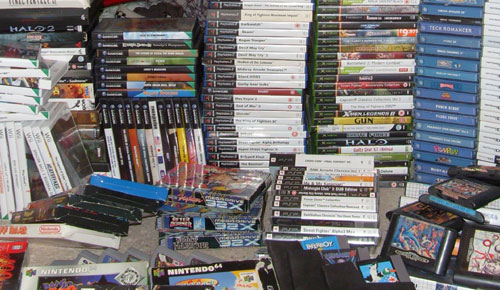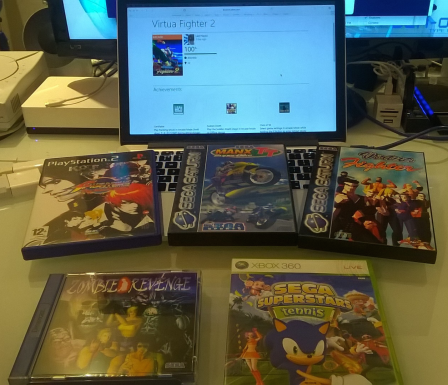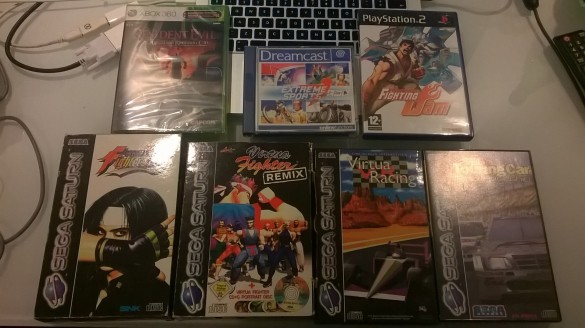
Not my pile of shame, but not far off.
One man, Harry Nezumi — some say brave, others foolish — stands against his backlog. With but five months between now and a move some 9,000 kms from home, does he have what it takes to complete all the outstanding games in his collection? Follow his quest, his Sisyphean toil, here on Sega Addicts as he tackles one hundred and seven games over twenty weeks. The journey will not be easy, the day grows dark and the hour late. Yet, there is hope. Click to read how Week 1 in this long campaign fared.
Completed Titles: Manx TT (Sat); Zombie Revenge (DC); King of Fighters ’94 (PS2); Virtua Fighter (Sat); Sega Superstars Tennis (360); Virtua Fighter 2 (XBLA).
With six titles under my belt from the first week alone, my tactics can be described as ‘low hanging fruit’. I’m sure later I will be like Tantalus, forlornly flailing at the prospect of finishing Panzer Dragoon Saga (estimated at 15 hours) or Skies of Arcadia (another 45 hours). To get off to a good start in terms of numbers, my love of arcade games has helped immeasurably. Nevertheless, this first week threw up a real surprise: Manx TT. While it is clearly not the objectively ‘best’ game I played this week — that would be Virtua Fighter 2 — it is the title I had the most fun with. Sadly, without a Sega Ages 2500 release, there’s no ‘arcade perfect’ home version to track down. This leaves me in the hands of emulation or the vagaries of trying to run mid-90s PC games. Neither fills me with pleasure. If you’ve ever been put off by Manx TT’s famous lack of depth, don’t be. Now that this game can be easily had for less than £5, there’s no reason to worry over the value proposition, because what’s there is genuinely excellent. Next week, hopefully unhampered by sickness, I’ll be trying to hit similar numbers, including at least one time-intensive title. For now, on with the reviews!
Game of the Week: Manx TT.
Nightmare of the Week: King of Fighters ’94.
Manx TT Superbike (Saturn) — This is the epitome of why Sega lost the 32-bit console war so convincingly. Like French cuirassiers facing off against German machine guns, Sega was simply ill-equipped and unwilling to change until too late. At a time when Metal Gear Solid and Syphon Filter were providing deeper, more cinematic experiences, Sega’s commitment to bringing the benzedrine burst of the arcades home seems counterintuitive. It’s almost irrelevant how good a conversion this is, and it’s very good indeed, Sega was out of touch and that consigns Manx TT to a footnote in the history of the 32-bit era. While the graphics are not up to the standards of the best Model 2 ports (Virtua Fighter 2 and Last Bronx own that accolade), the impression of speed is breathtaking. Furthermore, the AI is most convincing as it races in three distinct ‘packs’, keeping the game alive for players of all skill levels. There’s even a great vertical depth here with the manual transmission option having six gears, but it’s the lack of horizontal depth that kills the package. The rush is more sugar than adrenaline as the two tracks overstay their welcome all too quickly. Nevertheless, when combined with analogue controls, there are few titles that can match Manx TT when it comes to conveying the speed and challenge of professional racing. 4/5
Zombie Revenge (Dreamcast) — A deceptive game in many ways, Zombie Revenge feels like it will be relatively straightforward but it eventually packs a real punch in terms of difficulty. Moreover, the first half of the experience feels shockingly slow, overly derivative and markedly less dynamic than the five year old Dynamite Deka. Yet, by the mid-point, the increasing number of set-pieces, combined with the ever-climbing difficulty, force the player to delve deep into the surprisingly complex move-set. With a second half that focusses on thrills and the hammy-as-all-Hell B-movie traditions of a House of the Dead game, Zombie Revenge eventually becomes the stylish, entertaining brawler it so desires. Question marks remain over longevity but not, fortunately, over entertainment. 3/5
King of Fighters ’94 (PS2) — At the end of the second episode of Neon Genesis Evangelion, Shinji is lying in his bed, harrowed from his fight against the angel Zachiel. Forced into an act of violence, a slice of his humanity and a sliver of sanity have drifted away from him. Misato appears at his door to remind him that he did a good thing, “a noble thing”. Her parting words are “hang in there”, for there will be more tribulations to come. Having defeated Rugal in King of Fighters ’94, I no longer have sympathy for Shinji. There are more King of Fighters games to come. I now have empathy. 2/5
Virtua Fighter (Sat) — Rough does not accurately describe this arcade port. There are famous mitigating circumstances for the half-baked, half-finished Virtua Fighter but, for all its problems, Sega correctly prioritized gameplay. Yes, polygons seem to exist in a state of quantum flux and yes, the backgrounds are outshone by the 32X. Nevertheless, it’s the gameplay that really brings the intangible ‘feel’ of the arcade home. The fluidity of Virtua Fighter, even at 24 fps, is still present — albeit only just — and, despite all the claims to the contrary, this kicked off the 32-bit generation with a step change. There would be better — much better — to come very soon, but ten minutes with Virtua Fighter was enough to convince the most ardent of 16-bitters that the future was in 3D. 3/5
Sega Superstars Tennis (360) — Perhaps the greatest homage in Superstars Tennis is not the mountain of unlockables, but the use of Virtua Tennis’ two button control scheme. This subtle nod demonstrates the amount of care and attention that Sumo Digital have injected into this package, making veterans of Sega’s arcade past and those who think NiGHTS should speak both feel at home. The arcade core forms a blessing and a curse, while it is instantly playable there is not a huge amount of mechanical depth. It’s a surprisingly slow-paced title and its child-focus means a lack of challenge on normal difficulty settings. With its emphasis on horizontal rather than vertical depth, Sega Superstars Tennis is the antithesis of ManxTT. Beyond the battle to unlock all the courts and characters through the varied Superstar mode, reasons for repeat play are scant. It is fun in its own right, the only question mark hangs over how long that fun really lasts. 3/5
Virtua Fighter 2 (XBLA) — It’s easy to forget, 20 years after the fact, the brutality of AM2’s opus. The arena’s are tight, the combatants fragile and, with the Xbox 360 giving out an arcade perfect 60 fps, there’s a fluidity to the violence that borders on artistic. The real genius is in the physics engine, get hit while kicking and expect your avatar, unbalanced by momentarily being on one leg, to crash to the floor. This, however, throws the unrealistic elements — the ‘moon jump’ and the inability to voluntarily move along the z-axis — into sharp relief. In truth, Virtua Fighter was always an iterative series and this was leaps and bounds ahead of the original in almost every regard. It remains a surprisingly unforgiving title, testament to its arcade heritage, but, as with every year for the past two decades, it is well worth the investment of time. 4/5




Bloody nora you’re braver than I am. My backlog is horrendous, much like the header image… but more 🙁
I’m starting to think it’s less ‘bravery’ and more bold-faced stupidity. The arcade games are a breeze, anything that needs more than a couple of hours though slows me down horrendously. Luckily, I don’t own too many JRPGS. What does your backlog stand at?